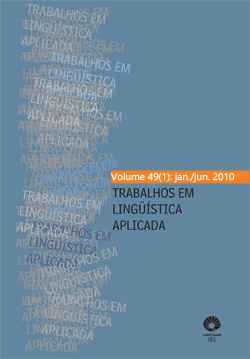Abstract
Este artigo avalia se a produção interlinguística de sujeitos brasileiros, aprendizes/falantes de inglês-L2, em contextos em que se espera o emprego da construção causativa-passiva do inglês (John had his hair cut), recebe influência de língua materna (transferência linguística). Relatam-se os resultados de um pequeno estudo conduzido com trinta e oito informantes brasileiros, de três níveis de proficiência na língua inglesa. O estudo aplicou a metodologia proposta em Jarvis (2000) para a análise do tema. Os resultados apontam para a complexidade do fenômeno da transferência linguística e para a importância de se submeterem os dados coletados a tratamento estatístico
ABSTRACT:
This article evaluates whether an L1 influence (language transfer) can be found in the interlanguage production of Brazilian subjects, learners/speakers of English as an L2, in contexts where the production of English causative-have construction (John had his hair cut) is expected. Results from a small study conducted with thirty-eight Brazilian subjects, distributed along three proficiency levels, are reported. The study applied Jarvis’ (2000) methodology for the study of language transfer. Results point to the complexity of the language transfer phenomenon and to the importance of undertaking a statistical analysis of the data.
Keywords: Language transfer; Portuguese-L1; English-L2; statistical analysis; interlanguage
References
BIBER, D. et. al. (1999). Longman grammar of spoken and written English. London: Longman.
CANÇADO, M. (2007). Verbal alternations in brazilian portuguese. [Manuscrito apresentado no V Congresso Internacional da ABRALIN (submetido à publicação)]. 2007. Disponível em: . Acesso em: 15 set. 2007.
CORDER, S. P. (1983). A role for the mother tongue. In: GASS, S.; SELINKER, L. (Org.). Language transfer in language learning. Amsterdam: John Benjamins.
FULLER, J. M. (1999). Between three languages: composite structure in interlanguage. Applied Linguistics, v.20, n.4, p. 534-461.
GASS, S.; SELINKER, L. (1994). Second language acquisition: an introductory course. Hillsdale, New Jersey: Lawrence Erlbaum Associates Publishers.
GILQUIN, G. (2003). Causative get and have: so close, so different. Journal of English Linguistics. v.31, n.2, p. 125-148.
HAINES, S.; STEWART, B. (2004). First Certificate masterclass: student’s book. Oxford: Oxford University Press.
JARVIS, S. (2000). Methodological rigor in the study of transfer: identifying L1 influence in interlanguage lexicon. Language Learning, v.50, n.2, p. 245-309.
KRASHEN, S. D. (1981). Second language acquisition and second language learning. Edição Online, 2002. Disponível em: <http://www.sdkrashen.com/SL_Acquisition_and_Learning/index.html>.
Acesso em 26 mai. 2008.
_______. (1983). Newmark’s ‘Ignorance Hypothesis’ and current second language acquisition theory. In: GASS, S.; SELINKER, L. (Org.). Language transfer in language learning. Rowley, Mass: Newsbury House.
MACKEY, A.; GASS, S. (2005). Second language research: methodology and design. Mahwah, New Jersey: Lawrence Erlbaum Associates Publishers.
NETO, A. A. H.; STEIN, C. E. (2003). Uma abordagem dos testes não-paramétricos com utilização do Excel. Disponível em: <http://home.furb.br/efrain/matematica/minicurso/artigo_11_09_2003.doc>.
Acesso em: 14 out. 2008 NUNAN, D. (1992). Research methods in language learning. Cambridge: Cambridge University Press.
ODLIN, T. (1989). Language transfer: cross-linguistic influence in language learning. Cambridge: Cambridge University Press OXFORD UNIVERSITY LANGUAGE CENTRE. (2008). Coordenação de Robert Vanderplank. Apresenta testes de nivelamento, informações sobre cursos e outros recursos. Disponível em . Acesso em 15 fev. 2008.
SCHACHTER, J. (1983). A new account of language transfer. In: GASS, S. & SELINKER, L. (Org.).
Language transfer in language learning. Amsterdam: John Benjamins.
SELINKER, L. (1972). Interlanguage. In: RICHARDS, J. Error analysis: perspectives on Second Language Acquisition. Harlow: Longman Group, 1984 [Publicado originalmente em IRAL, Vol. X/3].
SWAN, M. (1986). Practical English usage. Oxford: Oxford University Press.
VINNITSKAYA, I.; FLYNN, S.; FOLEY, C. (2003). The Acquisition of relative clauses in a third language: comparing adults and children. In: GENERATIVE APPROACHES TO SECOND LANGUAGE ACQUISITION CONFERENCE (GASLA), 6, 2002, Somerville, MA. Proceedings…, Juana M.
Liceras et al. (Ed.), Cascadilla Proceedings Project, p. 340-345.
ZOBL, H (1980). Developmental and transfer errors: their common bases and (possibly) differential effects o subsequent learning. TESOL Quarterly, v. 14, n. 4, pp. 469-478.
O periódico Trabalhos em Linguística Aplicada utiliza a licença do Creative Commons (CC), preservando assim, a integridade dos artigos em ambiente de acesso aberto, em que:
- A publicação se reserva o direito de efetuar, nos originais, alterações de ordem normativa, ortográfica e gramatical, com vistas a manter o padrão culto da língua, respeitando, porém, o estilo dos autores;
- Os originais não serão devolvidos aos autores;
- Os autores mantêm os direitos totais sobre seus trabalhos publicados na Trabalhos de Linguística Aplicada, ficando sua reimpressão total ou parcial, depósito ou republicação sujeita à indicação de primeira publicação na revista, por meio da licença CC-BY;
- Deve ser consignada a fonte de publicação original;
- As opiniões emitidas pelos autores dos artigos são de sua exclusiva responsabilidade.

